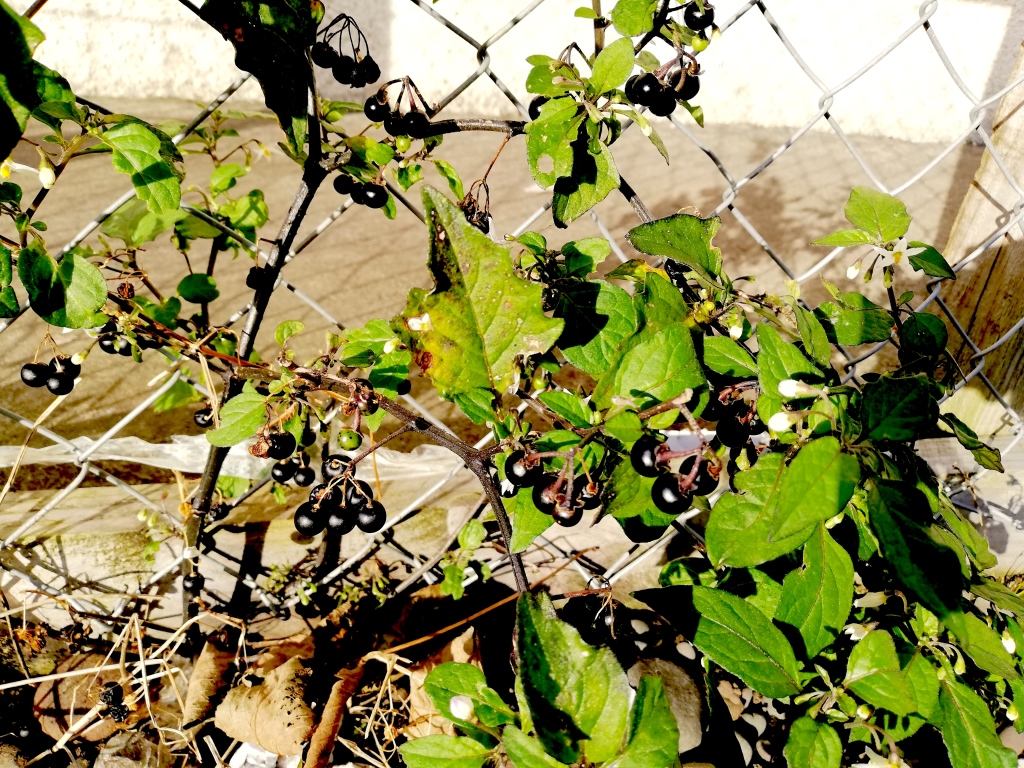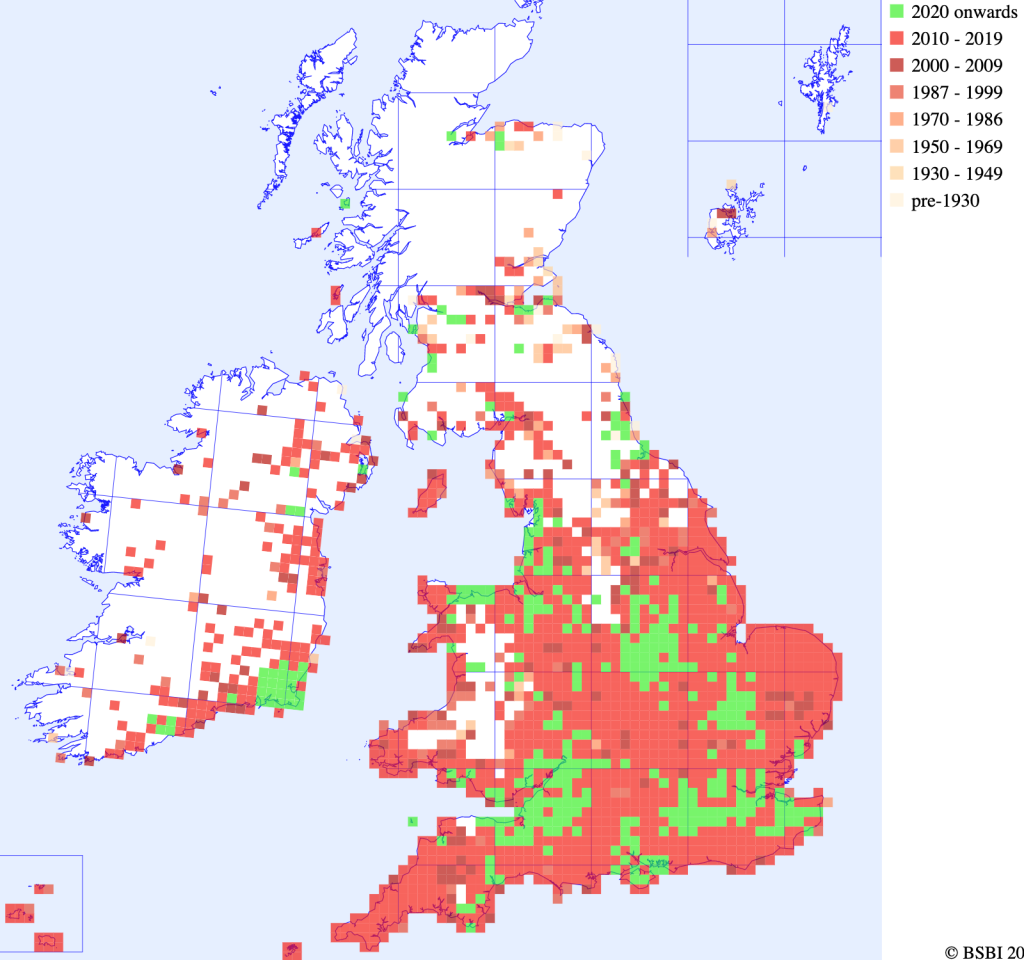I met this plant often during my childhood in rural England. My mother warned me not to eat the poisonous berries. Yes, it is another member of the Solanaceae, the family known for tomatoes and potatoes but also for its various highly poisonous members. We’ve already discussed three others on this web site (see the note at the end of this article).

In many parts of the world, Solanum nigrum is considered to be a noxious weed, one to eradicate with herbicides (see Zou et al. 2019). Elsewhere it is known as traditional medicine and even a food (Defelice, 2003). According to some gastronomy researchers, it can be used to make good soup (Sugumar and Guha 2020). Here in Scotland, it is an interesting wild plant said to be ‘rare’ in recent books, and a worthy ‘Plant of the Week’. It has ripe berries at the moment.
Solanum nigrum is a short-lived annual plant, never more than 50 cm tall, often much less. Its seeds may remain viable in the soil for 20 years; where the soil is disturbed and the temperature is over 18 oC (preferably fluctuating) they germinate. In Scotland this usually occurs in June and seedlings take just a few weeks to flower. The flowers look like those of tomato or potato, but they are white. The berries are green at first, turning shiny-black when ripe. They are eaten by birds and mammals, then dispersed in droppings.

Is it a native plant? It was first recorded long ago in Gerard’s herbal (1597). He says : “it cometh up in many places, and not only in gardens…but also neere common high waies, the borders of fieldes, by old wals and ruinous places”. He called it Solanum hortense the ‘Garden Nightshade’ but Linnaeus later named it Solanum nigrum. The plant is mentioned in WJ Hooker’s 1821 Flora Scotica as a plant of “waste places near towns and villages”. Clapham, Tutin and Warburg (1959) said simply that it is a native in England but introduced in Scotland. Stace (2019) agrees.
Is it truly rare in Scotland? Fairly rare. There are only four records in the total of over 60,000 records (to date) of the Urban Flora data-base. I’ve seen a lot in Ayrshire – just outside the Old Kirk Cemetery in Ayr and beside the Co-op shop in Ballantrae. It likes a fertile soil high in nitrogen: Gilbert (1989), writing about his allotment survey, says it is ‘abundant in certain areas’. However, I think he did not extend his survey to Scotland. The BSBI provides the big picture (see the map). There are quite many records in the Central Belt of Scotland, elsewhere it is rare.
Is it poisonous? There is a controversy here. In common with potatoes, tomatoes and aubergines, all parts of the plant contain the bitter-tasting and poisonous glycoalkaloid solanine which was first isolated from S. nigrum in 1820. This tends to be more concentrated in the green parts of plants as its manufacture requires photosynthesis. However, I cannot find any report of poisoning by S. nigrum, except one paper in a rather obscure journal that I am unable to access. In contrast, poisoning by potatoes has often been reported, which is one reason to peel carefully your potatoes and make sure they haven’t turned green by exposure to light. Beware, temperatures exceeding 210 oC are needed to decompose the molecule.; simple cooking will not break solanine.

Might the species be poisonous in the West and non-poisonous in the East? It’s possible. Stace (2019) lists several hybrids and subspecies, and Defelice (2003) playfully calls the species S. nigrum et al. Given this known variability, the plants in China may have a lower solanine concentration; or the people eating it may have a gene for an enzyme that breaks solanine down. Far more likely is that its reputation in the West is unfounded – based on confusion with other European nightshades.
The mechanism of solanine toxicity is that the chemical blocks the action of the enzyme cholinesterase, and that in turn blocks the metabolism of the neurotransmitter acetylcholine. Neurological disturbances occur, and a sore tummy as well. The lethal dose is 3 mg per kg of body weight. On the forever-optimistic web-site of Plants for the Future, I have just read about its use to make jam. It warns to use only the ripe berries, not the green ones. Perhaps Jams for the Future will be made from varieties of S. nigrum which have been bred to reduce the solanine. I do eat home-made green tomato chutney and I wonder if I should quit. I’ve got a stock of my 2018 chutney (a vintage year). It looks pretty terrible but it tastes good and no symptoms of poisoning have occurred yet.
The bitter taste of solanine presumably serves to discourage herbivores. I had a nibble of the S. nigrum leaf, and I can confirm the taste is somewhat bitter. I tried a ripe berry too; it was not bitter but sweet and rather tasty. I have had no neurological disturbances so far, but please don’t consider this observation to be an encouragement to eat the berries. ‘Tasting’ is not the same as ‘eating’.

Our ’friendly’ cultivated relatives of nightshade are tomato, potato and aubergine. It’s worth recalling that the original wild tomato is not much bigger than a pea and when brought from Peru to Europe by the Spanish in the 16th Century it was viewed with suspicion because of its resemblance to nightshades and its tendency to stain pewter plates. Linnaeus had no hesitation in placing tomato in the genus Solanum, alongside the nightshades, and though it has sometimes been called Lycopersicon esculentum (and earlier it was Solanum ganchouenense) it is now safely back where it belongs as Linnaeus’s Solanum lycopersicum.
The Royal Botanic Gardens in Edinburgh has a herbarium specimen which is an official holotype for Solanum nigrum, although it bears the old name Solanum ganchouenense and came from the herbarium of French botanist Augustin Abel Hector Léveillé (1864-1918). I discovered that his rich herbarium was acquired by George Forrest the Scottish botanical explorer, and then donated to the RBGE. You should be able to view this actual specimen by clicking https://www.gbif.org/occurrence/575160200
Footnote. You may want to look again at the three previous articles we’ve published on plants of the Solanaceae: click on these links:
References
Clapham AR, Tutin TG and Warburg EF (1959) Excursion Flora of the British Isles. Cambridge University Press.
Defelice MS (2003) The Black Nightshades, Solanum nigrum L. et al. Poison, Poultice and Pie. Weed Technology 17, 421-427. https://doi.org/10.1614/0890-037X(2003)017[0421:TBNSNL]2.0.CO;2
Gilbert OL (1989) The ecology of urban habitats. Chapman and Hall.
Stace C (2019) New Flora of the British Isles. C&M Floristics.
Sugumar KS and Guha P (2020) Study on the formulation and optimization of functional soup mix of Solanum nigrum leaves. International Journal of Gastronomy and Food Science 20, 100208 https://doi.org/10.1016/j.ijgfs.2020.100208
Zou T et al. (2019) Detection of glyphosate resistance in black nightshade Solanum nigrum from Hunan, China. Scienceasia DOI : 10.2306/scienceasia1513-1874.2019.45.419
John Grace